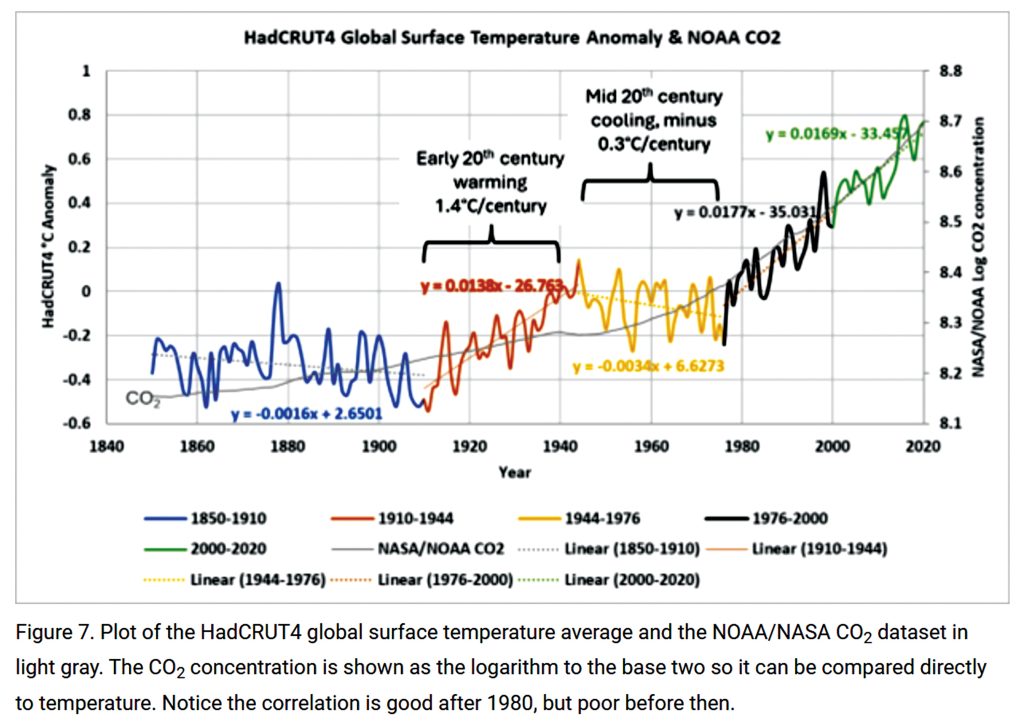
The Partial Observer by Roger Caiazza
On Natural Climate Variability
The rationale for changing New York’s energy system away from fossil fuels in the Climate Leadership and Community Protection Act is the alleged link between climate change and greenhouse gas emissions. This presumes that natural climate variability is not appreciably affecting the observed recent warming. I think that presumption does not stand up to scrutiny.
The video “Climate the Movie: The Cold Truth” (https://youtu.be/v_NPby_p5Lg) includes a very good description of historical temperatures and CO2 trends. It provides examples why claims that today’s observations indicate unprecedented heat in earth’s history are wrong. Over geologic time scales, temperatures today are not at all unusual and because we are in an ice age, all previous non-ice age geologic epochs were warmer. Over the last 2,000 years there has been a Roman Warm Period and a Medieval Warm Period, and both had temperatures warmer than today. As shown in the following figure, over the last 175 years temperatures have been warming up since the end of the Little Ice Age but carbon dioxide emissions have only risen sharply over the last 75 years. That means that natural climatic variability must have driven all the warming observed prior to 1950.
From 1910 to 1944, there was little change in the carbon dioxide trend, but the temperature trended up markedly and in a similar fashion to the recent observed warming. Carbon dioxide emissions don’t start to rise significantly until the end of World War II in 1945, but from 1944 to 1976 the global temperature trended down. Since then, temperature and carbon dioxide correlate well. The Climate Act presumes that the recent correlation proves causation but ignores the fact that prior to 1976 there is no correlation.
Although the satellite data only goes back to 1979, this is the most representative data set because it covers the entire globe equally. Over the last 10 months, the NASA satellite data temperature observations show a spike of observed global warming and record high temperatures that is an unprecedented climate event. The fact that this event was not accompanied by a spike in carbon dioxide emissions also contradicts the Climate Act rationale.
Scientists are still debating the reason for the recent increase in temperatures. One possibility is the Tonga-Hunga underwater volcanic eruption that blasted unprecedented amounts of water vapor into high levels of the atmosphere. Water vapor is more effective than CO2 as a greenhouse gas, so this could be part of the reason for the recent warming spike. It also injected particulates that cause cooling, so its impact is still being debated. In addition, the winter of 2023 occurred during an El Niño, when the ocean releases heat into the atmosphere and has been associated with marked increases in global temperatures in the past. However, the 2023 El Niño was a weak year, so its contribution to the observed warming was minimal.
Dr. Judith Curry describes three potential reasons (https://judithcurry.com/2023/08/14/state-of-the-climate-summer-2023/). The slow decline in springtime snow extent has been linked to the warming trend as we come out of the Little Ice Age because less snow means less sunlight reflected to space. Clouds affect global temperatures. Within the atmosphere, more low clouds reduce temperatures by reflecting more sunlight but increased high clouds increase temperatures. Particles or aerosols also scatter light and can affect temperatures by blocking sunlight. Curry attributes the observed warming to the reduction in reflection from the atmosphere driven by reduced low-level cloudiness and, to a lesser extent, a reduction in atmospheric aerosol particles. Notably, she points out that increasing CO2 effects are “lost in the noise” which directly contradicts the Climate Act narrative.
The rationale for the multi-billion Climate Act net-zero transition is the alleged link between climate change and greenhouse gas emissions. Undoubtedly the emissions increases have some greenhouse effect on global temperatures, but the effects of natural climate variability not only must have been responsible for all the historical variations in global temperatures but also appear to be the primary driver even during the most recent period when carbon dioxide emissions and global temperatures are well-correlated. The rationale for the Climate Act transition is weak at best. More information is available at https://pragmaticenvironmentalistofnewyork.blog/2024/04/12/natural-climate-variability/
Born in Cooperstown and a graduate of Oneonta High School, Roger Caiazza holds a bachelor’s in meteorology from SUNY Oneonta and a master’s in meteorology from the University of Alberta, Edmonton. Before his retirement in 2018, he was a certified consulting meteorologist and worked in the air quality industry for more than 40 years. The goal of Caiazza’s blog, “Pragmatic Environmentalist of New York,” is to explain the importance of balancing risks and benefits of both sides of environmental issues.


This is hilarious. Homie really tried to intellectualize blatant anti-science. Love it! Not surprising from a boomer and registered Republican, but sad that Otsego Fake News chose to give him a voice.
News flash Roger: anthropogenic climate change is real. But hey, why let the facts get in the way of your feelings.
Mr. Jeffers,
I do not deny that anthropogenic climate change is real but believe that natural variability is responsible for most of the observed warming. I showed why I believe that and you just called me names.